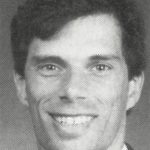Longtime WJ Editor Bids Farewell
This issue of The Waterways Journal is the last one with my name on the masthead, after 27 years as editor and five years before that as assistant editor. Effective July 1, I am retiring from the job that I’ve held for more than half my life.

On August 26, 1991, I walked into the WJ offices in the Security Building in downtown St. Louis to begin my new job as assistant editor. Even though I had grown up in St. Louis and worked in several journalism jobs, I knew little about the river and its industries other than having read “Huckleberry Finn” in college and “Life on the Mississippi” after college.
Fortunately for me, another new employee started the same day. Rick Bensinger, with a long history in the industry, came aboard as sales manager, and he would serve as a mentor to me in all things barging while we worked together over the next decade (and as a friend to this day). Rick, along with publisher Nelson Spencer, editor Jack Simpson and Inland River Record editor Dan Owen, gave me about as complete an education about the business as anyone not actually working on a tow could hope for.
The last 33 years have been an interesting time for the barge industry. When I came aboard in 1991, tank barge operators were still talking about the implementation of the Oil Pollution Act of 1990. Since then, we have seen a number of major and minor changes: a new licensing regime, the rise and fall of the Pilots Agree movement, Subchapter M, personnel shortages and the ongoing transitions to alternative fuels and alternative cargoes, to name just a few.
There have also been peaks and troughs in boat- and barge-building, depending on the fickle nature of the various economic forces that impact the freight transportation industry.
Of course, the last 33 years have also brought numerous major weather-related (dare I say climate-related?) events: droughts, floods—sometimes occurring in the same year—and hurricanes.
The rebuilding of our nation’s infrastructure has been a constant theme over the last three decades. WJ staffers have been fortunate to attend ribbon-cutting ceremonies for several major lock-and-dam projects, including Robert C. Byrd, Mel Price, Winfield, Montgomery Point and McAlpine (second lock). And then there’s the granddaddy of them all, Olmsted Locks and Dam, the construction of which lasted the majority of my time here.
That brings me to one of the biggest victories the industry has recorded over the last three decades: the increased recognition, in the public and in Congress, that we as a nation need to commit more resources to improving our infrastructure, namely locks and dams. Thanks in large part to the hard work of industry advocacy groups, Congress has found new ways to fund vital construction projects. In the early 1990s, one would often hear the barge industry referred to as “invisible.” Many were content, it seemed, to operate with as little fanfare as possible, perhaps hoping to avoid onerous new regulations. But over time, a new mindset took over, of spreading the word about the copious environmental and economic benefits of barging. Industry leaders testified before Congress, sought out story opportunities in the media and amped up efforts to portray the barge and towing industry in a positive light. This helped both on the infrastructure-appropriations and recruiting fronts.

Back here at the WJ, I have been extremely lucky to have been surrounded by excellent teammates throughout my career. Nelson Spencer, who hired me, has not only been a top-notch boss, but he’s also one of the most gifted writers who have graced these pages. Remarkably, Nelson is still on the team after 50-plus years, although he has dialed back his WJ activities somewhat in the last few years. His son, Spence, is now Master of this vessel, and he has brought about some major changes in the last 15 years, most notably the launch and steady growth of the Inland Marine Expo. Under Spence’s leadership, the WJ family—now known as Bound Media Group—includes publications in the agriculture industry and Great Lakes maritime industry, among others.
On the editorial side, we all—I as editor and you as readers—have been very well served by the team that’s currently in place. Senior Staff Writer David Murray has provided deep analysis on a wide variety of topics in his more than 16 years on the staff. For the last 10 or so years he has also taken on the role of writing the WJ editorial. Shelley Byrne came aboard some five years ago and, in addition to covering the Ohio Valley, quickly revealed herself to be a top copy editor, and she now serves that role for all of the publications under the Bound Media Group umbrella.
And finally Frank McCormack, who hired on full time nine years ago as Gulf Coast correspondent, quickly became an integral part of both the WJ and of the industry we cover. His technical knowledge, ever-broadening list of industry contacts and work ethic are huge assets to the WJ staff. I know the WJ will be in excellent hands with Frank as the new editor.
So as I come off watch for the last time, I just want to say thanks for three decades of great memories. It’s been a wonderful ride.



